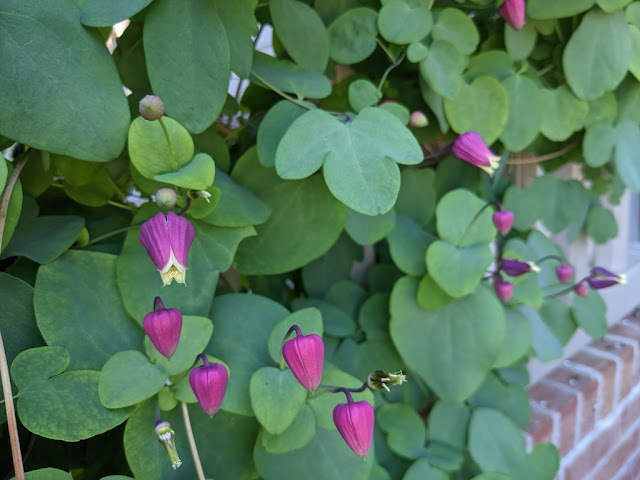The genus Clematis has given us a great many beautiful landscape plants from regions around the world. Many of the species and their cultivars that were used in my gardens of the Upper Midwest have large showy blooms. That's not really the case with Florida's six native species, but they have a charm of their own. I've written about most of these previously in this blog. Today, I'm writing about one I haven't yet featured - whiteleaf leather-flower - C. glaucophylla.
Whiteleaf leather-flower is yet another vining herbaceous perennial that produces upside-down tulip-shaped blooms. My oldest granddaughter, Caroline, thinks that they look like fairy hats....... This species has a fairly restricted distribution in Florida; it is found in a 6-county region of the central Panhandle and has been reported also in Levy County. It also has a fairly restricted range outside of Florida, having been vouchered in Georgia, Alabama, and Mississippi - with a disjunct population in Oklahoma. Throughout this range, it seems to prefer the rich moist soils in the semi-shaded conditions found in habitats such as streambanks.
Like others in this genus, the herbaceous stems die back to the ground each winter and reemerge again in spring. Each of the many stems can reach a mature length of 15 feet and it sprawls up and over everything in its path. If it wasn't for its spectacular flowers, it could be considered a nuisance - and adding it to a landscape should be well considered beforehand. The leaves are wider than long and have 3 distinct lobes. As the common name suggests, the undersides of this foliage has a whitish blush, but the leaves are, in fact, glabrous. They are positioned opposite each other along the stems.
Flowering occurs in late spring to very early summer. Buds are produced in the leaf axils all along the stem. Each turns downward as it matures and begins to turn a rich lavender-pink in color. The inner side of each flower is white - as shown in the above photos. Clematis flowers are favorites of bees (especially bumblebees) and butterflies. As such they are an excellent addition to a pollinator garden. They simply need a trellis to climb on and relatively moist soil. Although beautiful, native Clematis are only rarely propagated by nurseries affiliated with FANN - the Florida Association of Native Nurseries. I have not seen this species offered at any time. I have grown other species of vining Clematis successfully from cuttings and from seed - though ripe seed may take 3-4 months to germinate.
The lower photo was taken by Charlotte Glen.



No comments:
Post a Comment
Please let me know if this site and the various postings have been useful to you.